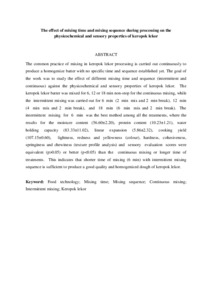Citation
Murad, Najwa Shamila and Ismail, Mohamad Afifi and Mahmud @ Ab Rashid, Nor-Khaizura and Mohammad Rashedi, Ismail-Fitry
(2017)
The effect of mixing time and mixing sequence during processing on the physicochemical and sensory properties of keropok lekor.
Journal of Science and Technology, 9 (4).
88 - 95.
ISSN 2229-8460; ESSN: 2600-7924
Abstract
The common practice of mixing in keropok lekor processing is carried out continuously to produce a homogenize batter with no specific time and sequence established yet. The goal of the work was to study the effect of different mixing time and sequence (intermittent and continuous) against the physicochemical and sensory properties of keropok lekor. The keropok lekor batter was mixed for 6, 12 or 18 min non-stop for the continuous mixing, while the intermittent mixing was carried out for 6 min (2 min mix and 2 min break), 12 min (4 min mix and 2 min break), and 18 min (6 min mix and 2 min break). The intermittent mixing for 6 min was the best method among all the treatments, where the results for the moisture content (56.60±2.20), protein content (10.23±1.21), water holding capacity (83.33±11.02), linear expansion (5.86±2.32), cooking yield (107.15±0.60), lightness, redness and yellowness (colour), hardness, cohesiveness, springiness and chewiness (texture profile analysis) and sensory evaluation scores were equivalent (p>0.05) or better (p<0.05) than the continuous mixing or longer time of treatments. This indicates that shorter time of mixing (6 min) with intermittent mixing sequence is sufficient to produce a good quality and homogenized dough of keropok lekor.
Download File
![[img]](http://psasir.upm.edu.my/63431/1.hassmallThumbnailVersion/The%20effect%20of%20mixing%20time%20and%20mixing%20sequence%20during%20processing.pdf)  Preview |
|
Text (Abstract)
The effect of mixing time and mixing sequence during processing.pdf
Download (5kB)
| Preview
|
|
Additional Metadata
Actions (login required)
 |
View Item |

